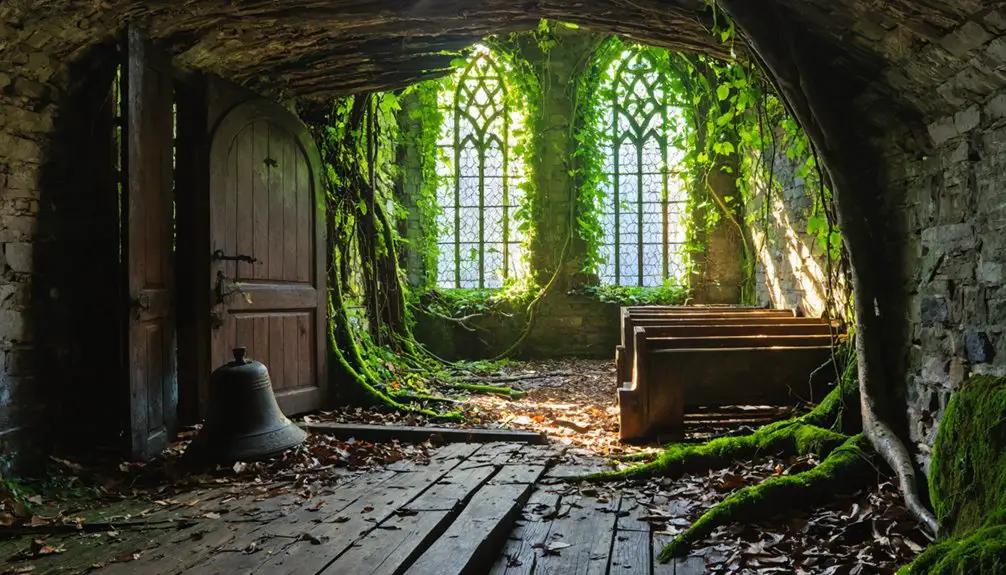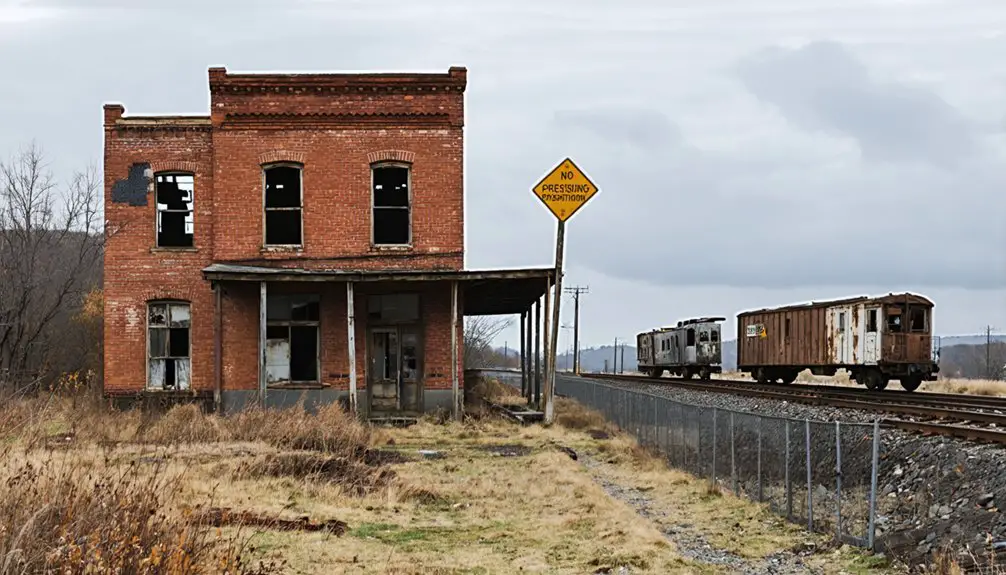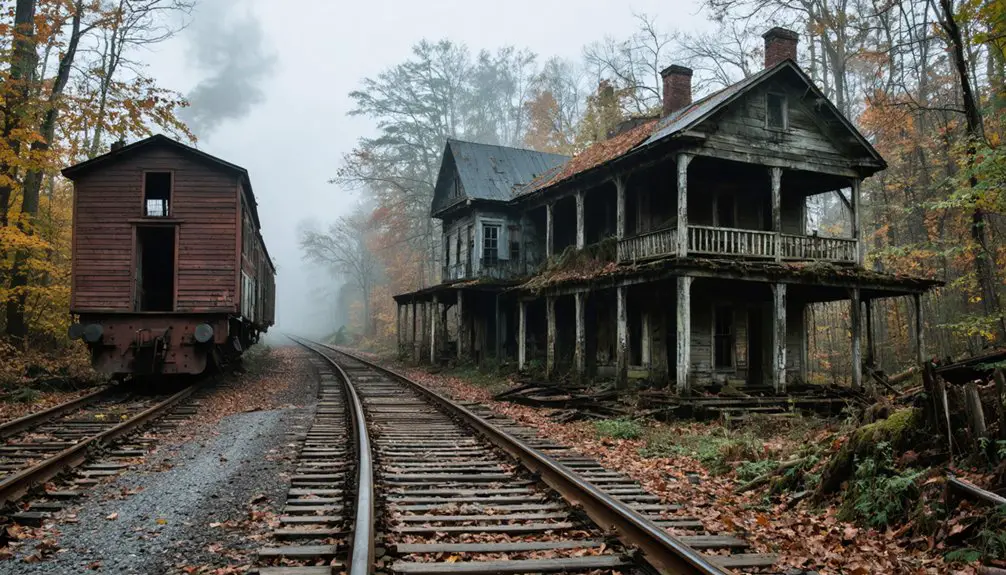You’ll find Scottglen’s remains along Indiana County’s Ghost Town Trail, where a thriving coal mining settlement once prospered in late 19th-century Pennsylvania. The town emerged during the region’s coal boom, employing 500 workers at Mansfield Coal and Coke Company’s No. 2 mine by 1883. After coal production peaked at 15 million tons in 1918, declining demand led to mine closures and population exodus. Today, mountain laurel and native wildflowers blanket the preserved foundations and remnants that tell a deeper story of Pennsylvania’s industrial heritage.
Key Takeaways
- Scottglen began as a thriving 19th-century coal mining settlement in Indiana County, Pennsylvania, centered around the Mansfield Coal and Coke Company.
- The town’s economy relied heavily on coal transportation via the Pennsylvania Railroad, employing approximately 500 workers at its peak.
- Declining coal production and market competition in the early 1900s led to mine closures and mass population exodus.
- The abandoned town has been reclaimed by nature, with former buildings now covered by mountain laurel and native wildflowers.
- Scottglen’s remains are preserved along Ghost Town Trail, including the Scottglen Bridge marker and remnants of company infrastructure.
The Rise of a Coal Mining Settlement
During the late 19th century’s coal boom, Scottglen emerged as a quintessential mining settlement in Indiana County, Pennsylvania, strategically positioned along the Pennsylvania Railroad‘s vital coal transport infrastructure.
Scottglen rose from Pennsylvania’s coal-rich landscape as a vital hub along the railroad’s expanding network of mining settlements.
Like other mining towns that faced transportation challenges, Scottglen dealt with steep grade issues that impacted operational costs.
As bituminous coal demand surged, the community development centered around extensive mining operations that would power America’s industrial revolution and wartime needs.
Similar to the Eliza Furnace operations nearby, the town employed dozens of workers to process raw materials.
You’ll find that Scottglen’s labor relations reflected the era’s typical company town structure, with mining corporations providing housing and essential services to their workforce.
The town’s growth paralleled Pennsylvania’s rising coal production, which peaked at 15 million tons in 1918.
Situated along the Ghost Town Trail corridor, Scottglen’s prosperity hinged on the efficiency of railroad transport systems, particularly the Ebensburg & Blacklick line, which navigated challenging mountain terrain through innovative switchback designs.
Life in a Company Town
If you’d worked in Scottglen’s coal mines during the late 1800s, you’d have faced grueling shifts underground with minimal safety protections and constant health hazards.
You could’ve found some relief through the town’s tight-knit social networks, where immigrant families and fellow miners formed supportive communities centered around churches and cultural gatherings.
Like the miners in Batsto who demanded cash payment instead of company scrip, workers often had to band together to fight for fair compensation and better working conditions.
Your survival often depended on these social bonds, as workers united to help injured colleagues, share resources during economic hardships, and maintain cultural traditions that provided stability in dangerous times.
As one of 500 mine workers employed at the Mansfield Coal and Coke Company’s No. 2 mine starting in 1883, you would have joined a massive workforce that shaped the region’s industrial development.
Daily Working Conditions
While coal towns like Scottglen promised steady employment, the daily working conditions proved brutally demanding for miners and their families. Deep underground, you’d face constant threats to worker safety and mining hazards during grueling 10-12 hour shifts, six days a week.
Minimal safety protocols left you vulnerable to accidents, respiratory diseases, and the ever-present danger of mine collapses.
Your typical workday included:
- Breathing coal dust in poorly ventilated shafts
- Performing intense physical labor with limited breaks
- Operating dangerous equipment with inadequate safety measures
- Enduring extreme temperatures and cramped conditions
- Working under constant pressure to meet production quotas
The company’s drive for profit often overshadowed concerns for miners’ wellbeing, leading to widespread health issues like black lung disease and frequent injuries that could leave families destitute. Much like how growing up in Appalachia shaped the lives of many, the harsh mining environment left lasting impacts on workers and their children.
Social Support Networks
Despite the harsh working conditions, Scottglen’s social support networks formed the backbone of daily life in this company town, creating a complex web of mutual aid and community resilience.
You’d find neighbors sharing childcare duties, organizing meals for injured miners’ families, and coordinating funeral arrangements through their churches and ethnic associations.
The town’s immigrant population maintained their collective identity through cultural festivals, mutual aid societies, and religious gatherings at multiple churches.
Schools doubled as community centers where you could attend social events, theater performances, and educational programs.
When illness or injury struck, informal support networks quickly mobilized to provide care and assistance.
These tight-knit social bonds, forged through shared hardships and cultural traditions, helped sustain Scottglen’s residents through difficult times until the mine’s eventual closure.
Railroad Connections and Economic Growth
During the late 19th century, Scottglen’s economic fortunes became intrinsically linked to the expansion of railroad infrastructure throughout southwestern Pennsylvania. The area’s railroad expansion revolutionized coal transportation and regional economic interconnectivity, particularly through the Chartiers Valley Railroad‘s strategic development. The Chartiers Valley Line played a crucial role as a key transportation corridor that shaped the region’s development. The addition of double track lines, a practice pioneered by the Pennsylvania Railroad since its inception, greatly enhanced the region’s transportation capacity.
- Double-tracking completion from Carnegie to Houston by 1904 amplified mining capacity.
- Branch lines constructed in the 1890s connected essential coal mining communities.
- Integration with Pennsylvania Railroad opened access to eastern markets.
- Nine daily passenger trains demonstrated robust regional connectivity.
- Multiple railroad partnerships enhanced market reach for local mining output.
The development of tunnels, including Glenn’s daylighting in 1898 and Bell’s expansion in 1895, transformed Scottglen into a significant hub within southwestern Pennsylvania’s coal transportation network.
This infrastructure investment catalyzed unprecedented economic growth, enabling efficient movement of both passengers and freight across the region.
Daily Operations and Mining Activities
The robust mining operations in Scottglen took shape through a carefully structured daily routine that maximized both safety and productivity.
You’d find fire bosses conducting essential gas checks twice daily using safety lamps, while miners worked in designated “splits” under strict ventilation standards maintaining 11,550 cubic feet of airflow at crosscuts.
Mining logistics centered around efficient coal extraction and transportation, with workers operating at various coal faces and loading the product into wagons for rail transport.
Coal safety protocols remained paramount – from the controlled use of permissible explosives to managing wet conditions underfoot in the headings.
Following the Buffalo Mining disaster, strict new safety measures were implemented across all mining operations to prevent future tragedies.
The operation’s success depended on specialized roles, including rope riders and drivers who guaranteed smooth coal movement from face to railcar, while maintaining accessibility in abandoned sections through careful pillar preservation.
The mines achieved remarkable production levels, contributing to Consolidation Coal Company’s position as the nation’s largest bituminous coal producer by 1927.
Architecture and Town Layout

Remnants of Scottglen’s architectural footprint reveal a carefully planned coal company town that maximized efficiency through its strategic layout.
You’ll find evidence of architectural simplicity in the surviving structures, where spatial constraints shaped the town’s development along railroad lines and natural terrain.
- Company-built wooden frame houses arranged in tight rows, emphasizing functionality over decoration
- Centrally positioned company store and hotel serving as the town’s commercial hub
- Churches and schools within walking distance of residential areas, fostering community connectivity
- Railroad infrastructure integrated directly into the town plan for coal transport
- Public buildings constructed of more durable materials like stone and brick, marking institutional presence
The town’s design exemplified the economic priorities of coal companies while maintaining essential community services within a compact, walkable footprint that you can still trace through remaining foundations and pathways. Similar to the Ghost Town Trail established in 1991, these architectural remnants provide valuable insights into Pennsylvania’s industrial heritage.
The Beginning of the Decline
During the early 1900s, Scottglen’s mining operations began to falter as the Western Pennsylvania coal industry faced increasing competition and decreased demand.
You’d have seen the first signs of trouble in the 1920s when the mines servicing Scottglen started closing, mirroring a regional downturn that affected numerous Pennsylvania coal towns.
The town’s complete dependence on coal mining meant that as operations ceased, families were forced to leave in search of work elsewhere, marking the beginning of Scottglen’s transformation into a ghost town.
Mining Operations Halt
Following World War I’s peak coal production in 1918, Scottglen’s mining operations began a steady decline that would ultimately seal the town’s fate. The combination of evolving mining technology and dramatic economic shifts transformed the once-thriving coal town into another Pennsylvania ghost town, following the pattern of nearby Wehrum and Claghorn.
- Production plummeted from 15 million tons annually after 1918
- Company-built infrastructure rapidly deteriorated as operations slowed
- Rail service on the Pennsylvania Railroad’s Ebensburg & Blacklick line declined
- Workers and families relocated to seek employment elsewhere
- Company stores, schools, and other services shut down permanently
The mines’ closure marked the end of Scottglen’s industrial era, leaving behind only scattered remnants of its coal-mining heritage.
Abandoned foundations, coke ovens, and other industrial artifacts still dot the landscape today.
Population Exodus Begins
As the coal industry’s decline accelerated in the early 1920s, Scottglen’s once-stable population began its irreversible exodus. You’d have witnessed families packing their belongings, seeking better opportunities in larger towns and cities as local mine closures devastated employment prospects.
This economic migration created a domino effect: as more residents departed, local businesses struggled to maintain sufficient customer bases, forcing closures that spurred additional departures.
The community disintegration intensified when essential services began shutting down. You’d have seen the systematic closure of schools, churches, and the company store – pillars that had once sustained daily life.
Within a few years of the mine closures, following patterns similar to nearby Wehrum, Scottglen’s remaining residents abandoned their homes, leaving behind a shell of what was once a thriving mining town.
Natural Reclamation and Current State

Through decades of natural succession, Scottglen’s former town sites have transformed into a thriving woodland ecosystem along Pennsylvania’s Ghost Town Trail. The ecological recovery has fostered expanded wildlife habitats, while remnants of the town’s history blend subtly into the revitalized landscape.
- Mountain laurel and native wildflowers now blanket areas where buildings once stood.
- The Scottglen Bridge marker stands as one of the few preserved structural elements.
- Active reclamation projects treat mine water and restore Blacklick Creek’s watershed.
- State Game Lands encompass much of the former town site, supporting regulated recreation.
- Multi-use trails follow historic railroad grades through the regenerated woodland.
Today, you’ll find the ghost town largely reclaimed by nature, with environmental restoration projects continuing to heal the mining-impacted landscape while preserving public access for outdoor activities.
Historical Significance Along Ghost Town Trail
While many Pennsylvania ghost towns have faded into obscurity, Scottglen’s historical significance remains preserved along the Ghost Town Trail, offering visitors a window into early 20th-century industrial development.
The trail follows the former Ebensburg and Black Lick Railroad corridor, which once served as the economic lifeline for coal mining communities like Scottglen, Wehrum, and Claghorn.
You’ll find cultural heritage preserved through remnants of company stores, workers’ housing foundations, and religious sites, including the nearby Russian Orthodox cemetery that reflects the region’s ethnic diversity.
The Ghost Town Trail’s historical preservation efforts showcase the broader story of Appalachian industrial boom-and-bust cycles, where towns flourished during coal mining’s heyday before succumbing to economic decline in the 1920s and 1930s.
Legacy in Pennsylvania’s Mining Heritage

Since the late 1700s, Pennsylvania’s bituminous coal mining has shaped the state’s industrial and cultural identity, with Scottglen representing one chapter in this expansive heritage. The evolution of mining technology, from early room-and-pillar methods to advanced longwall systems, reflects the industry’s continuous adaptation to growing demands.
Pennsylvania’s coal mining legacy spans centuries, evolving from basic extraction to sophisticated methods while shaping the state’s identity.
- Over 51,000 miners sacrificed their lives, commemorated in historical records that honor their contributions.
- Rich cultural heritage emerged in mining communities, fostering shared traditions and values.
- Extensive archives preserve vital mining records, certificates, and production data.
- Pittsburgh’s industrial growth relied heavily on local coal, consuming 400+ tons daily by 1830.
- Mining innovations in the Connellsville region revolutionized coke production for steel manufacturing.
Today, you’ll find Scottglen’s story preserved within Pennsylvania’s State Archives, alongside thousands of other records documenting the state’s profound mining legacy.
Frequently Asked Questions
Are There Any Documented Paranormal Activities or Ghost Stories From Scottglen?
You won’t find documented paranormal investigations or ghost sightings from Scottglen, as historical records focus solely on its coal mining heritage rather than supernatural activity, with no verified haunting reports available.
What Happened to the Residents After They Left Scottglen?
You’ll find residents’ stories show they scattered to nearby industrial cities like Pittsburgh, following railroad lines to find new mining or factory work while their tight-knit community networks gradually dissolved over time.
Was Scottglen Ever Involved in Any Major Mining Accidents?
Based on available mining safety records and accident reports, there’s no evidence that Scottglen experienced any major mining disasters, though it likely faced common smaller incidents typical of Pennsylvania coal operations.
Were There Any Notable Crimes or Significant Incidents in Scottglen?
You won’t find notable crimes or significant incidents in existing records. The town’s crime history and notable events centered on economic decline, with no documented criminal activity of historical significance.
Did Any Famous People or Historical Figures Come From Scottglen?
You won’t find any documented famous residents or historical figures from this town. Unlike nearby Wehrum, which had Warren Delano’s influence, research shows no notable personalities emerged from Scottglen’s brief mining history.
References
- https://en.wikipedia.org/wiki/Ghost_Town_Trail
- https://www.thetravel.com/what-to-know-about-hiking-the-ghost-town-trail-in-pennsylvania/
- https://indianacountyparks.org/our-trails/ghost-town-trail/ghost-town-trail-history/
- https://kids.kiddle.co/Ghost_Town_Trail
- https://uncoveringpa.com/ghost-towns-in-pa
- https://visitpago.com/the-history-of-the-shawmuts-rise-and-fall/
- http://www.coalmininghistorypa.org/annualreport/1904/1904 Anthracite Annual Report pdf from Univ of Scranton.pdf
- https://en.wikipedia.org/wiki/List_of_ghost_towns_in_Pennsylvania
- https://scott-twp.com/township/about-scott-township/
- https://www.popularmechanics.com/culture/g34498423/company-towns-to-visit/



